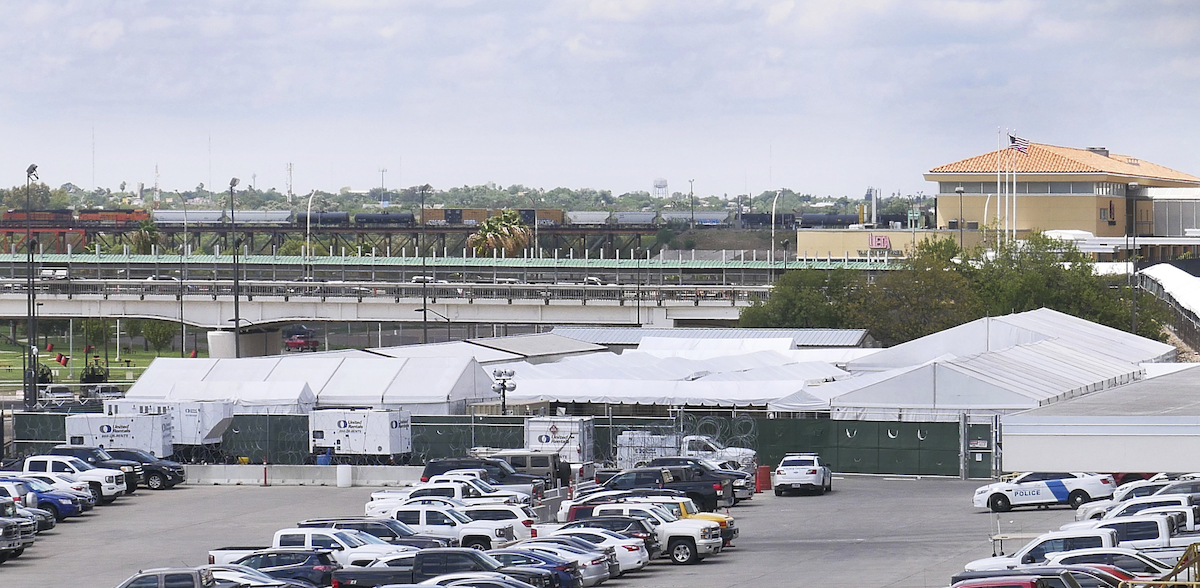

Customs and Border Protection Laredo Port Director Albert Flores shows one of four Master Courtrooms where immigrants seeking asylum will face an asylum judge via a virtual video conference as members of the media were given a tour, Tuesday, Sept. 10, 2019, of the Migrant Protection Protocols Immigration Hearing Facilities in Laredo. (Ricardo Santos/The Laredo Morning Times via AP)
By CEDAR ATTANASIO, Associated Press
EL PASO, Texas (AP) — The Trump administration is ready to open a tent court on the border to help handle tens of thousands of cases of asylum seekers forced to wait in Mexico, with hearings held entirely by videoconference.
The court, or “soft-sided” facility as U.S. officials call it, is scheduled to begin operations Monday in Laredo, Texas. Another is expected to open soon in Brownsville in the Rio Grande Valley, the busiest corridor for illegal crossings.
The administration introduced its “Remain in Mexico” policy in San Diego in January and later expanded it to El Paso, but hearings there are conducted inside large buildings with normal courtrooms, and the judge usually appears in person.
The policy, assailed by critics for making families and young children wait in violent Mexico border cities, has become a key piece of the U.S. response to a large increase in asylum-seeking families, especially from Central America.
Mexico allowed for its rapid expansion in a June 7 pact that spared it, at least temporarily, from threats of tariff increases by President Donald Trump.
Mexico’s Foreign Relations Secretary Marcelo Ebrard and U.S. Vice President Mike Pence agreed Tuesday to expand the policy “to the fullest extent possible,” according to a summary of their meeting provided by the White House.
About 40,000 non-Mexican asylum seekers have been forced to wait in Mexico while their cases wind through clogged U.S. immigration courts, according to the Mexican government. The number soared after the June agreement between the U.S. and Mexico, and the policy was expanded to Laredo and Brownsville.
The Laredo court will manage as many as 300 cases a day, said Alberto Flores, port director for U.S. Customs and Border Protection, said during a tour for journalists on Tuesday that was streamed by reporter Brenda Camacho of KGNS-TV.
Asylum seekers have been told to report to Nuevo Laredo on the Mexico side of the border at least four hours before their court times, Flores said during a media tour of the 30,000-square foot (2,787-square-meter) facility.


Located a short distance from the Rio Grande, the Migrant Protection Protocols Immigration Hearing Facilities in Laredo are adjacent to the Gateway to the Americas International Bridge. (Ricardo Santos/The Laredo Morning Times via AP)
Details of how the tent courts will operate have been scarce. Attorneys are still trying to determine how much access they will have and if they will be able to meet privately with clients before a hearing—even though journalists were shown 14 rooms for attorney-client discussions.
There are four courtrooms for initial scheduling hearings, each one designed to seat 50 migrants at a time in rows of benches, with folding tables available if they need to approach the video camera that feeds images to a judge, who will appear on a large screen from another city.
“Everything is going to be virtual,” Flores said.
For substantive hearings that address the merits of an asylum claim and typically last hours, there are 18 small rooms in adjoining shipping containers, each equipped with two chairs, table and screen for the judge to appear remotely.
There’s a children’s waiting area with brightly colored, kid-sized chairs and baby-changing tables near an area with portable toilets.
Migrants who fear persecution in Mexico, in addition to their home country, can make their case to an asylum officer who will interview them from an office in Houston.
Many other migrants are waiting in Mexican border cities just to make their initial claims for asylum at a U.S. border crossing. The Associated Press found about 19,000 names on waiting lists in four cities visited in late July.
The U.S. government does not manage the lists, so there’s no uniform system to prioritize asylum seekers who may be at a higher risk for extortion, persecution or medical problems. Lawyers along the border say many of their clients have been kidnapped, robbed, or sexually assaulted while they waited for their court date.
Mexico’s immigration crackdown, which includes sending thousands of troops to its borders, has contributed to a sharp drop in illegal crossings. U.S. Border Patrol arrests along the Mexico border in August fell to their lowest level since January, though they are still relatively high.
Pence highlighted the “Remain in Mexico” policy, called “Migrant Protection Protocols” by U.S. officials, during his meeting Tuesday with Mexico’s top diplomat at the White House. He commended Mexico’s “meaningful and unprecedented steps to help curb the flow of illegal immigration.”
“The leaders agreed that while progress has been made, more work remains in order to further reduce the flow of illegal migrants to the United States,” according to the White House summary of the meeting.
***
Associated Press writer Elliot Spagat in San Diego contributed to this report.


